前言
這是Rem Koolhaas 雷姆•庫哈斯在英國AA就讀時,1972年的畢業設計作品(與Madelon Vreisendorp, , 和 Zoe Zenghelis合作),在西柏林,人民通過牆這一自我囚禁的手段獲得自由,柏林牆之「內」,是一座都市監獄。
「逃離,或建築自願的囚徒」這一作品包含了十八幅繪圖、水彩和拼貼。這些強烈的圖像故事反映了庫哈斯早年作為記者和編劇的直覺,是當代都市亦真亦幻的暢想。」——MOMA 紐約當代美術館的作品描述
文末詩歌原文為法語,由Stefan Weber 翻譯成英文
逃離,或建築自願的囚徒
Exodus, or the voluntary prisoners of architecture
Rem Koolhaas, Madelon Vreisendorp, Elia Zenghelis, and Zoe Zenghelis (1972)
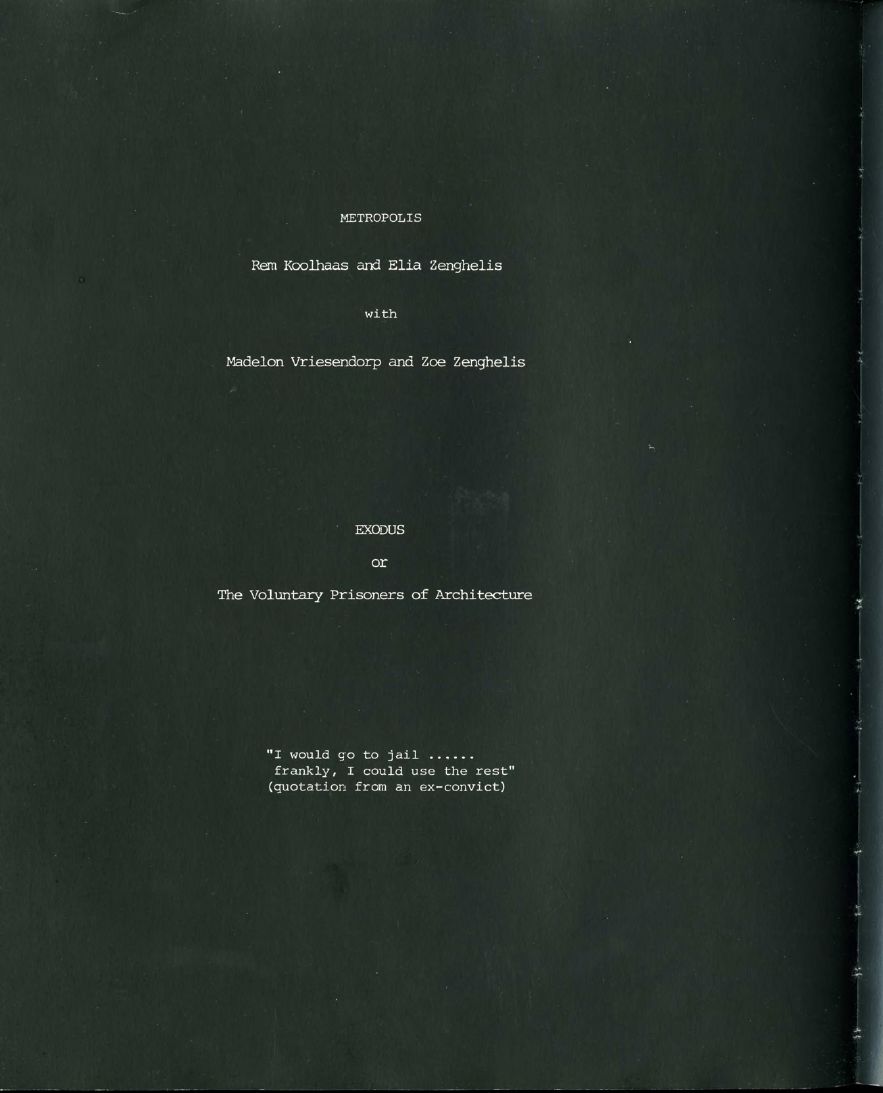

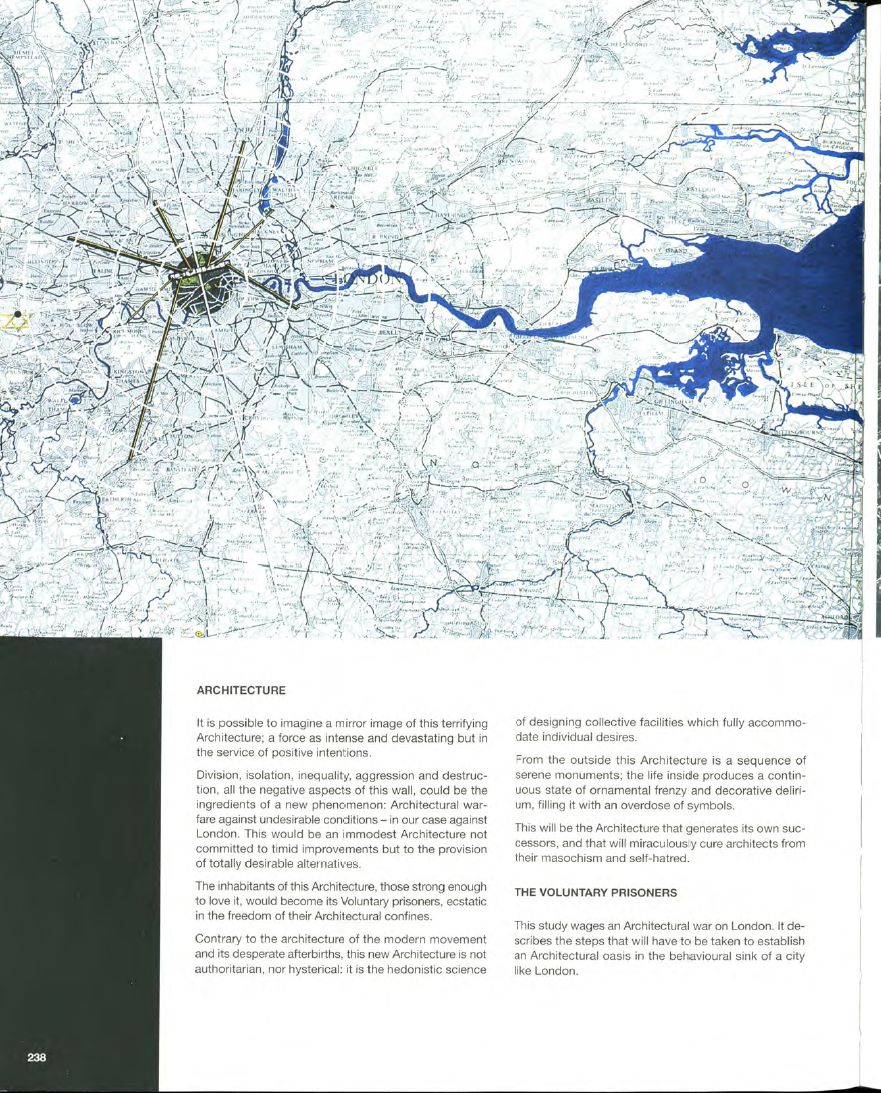








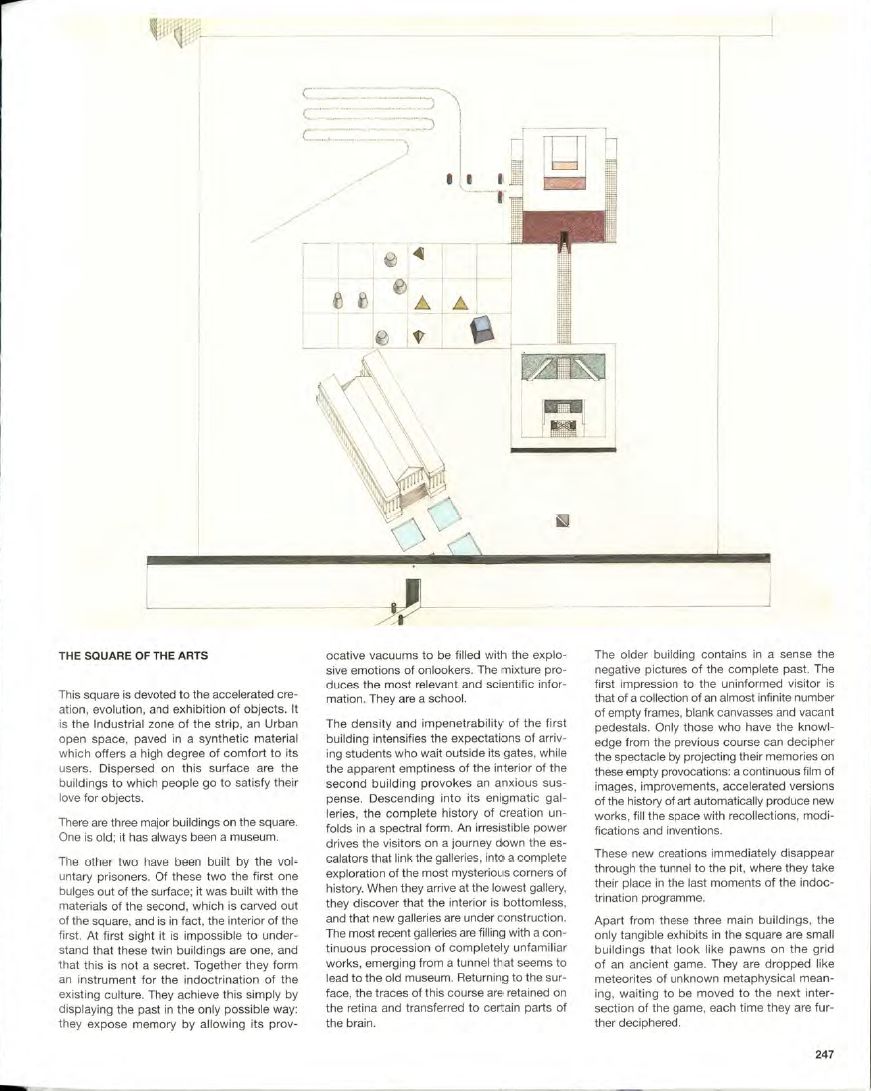



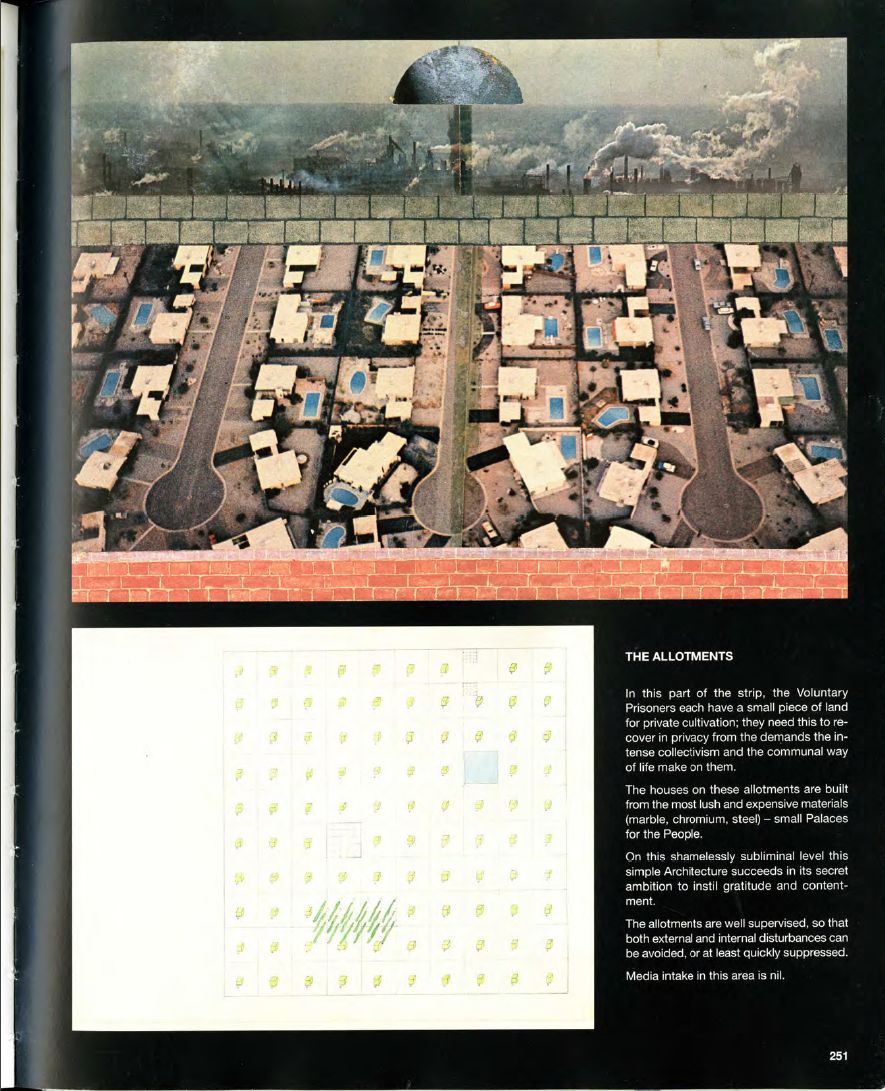



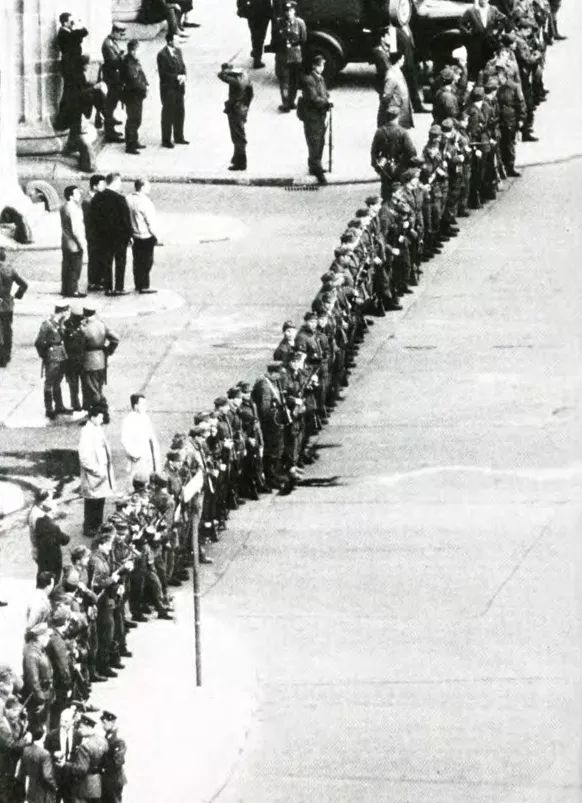
序Prologue
從前,一座城市被一分為二。一半成了好城,另一半成了壞城。
壞城裡的人開始蜂擁而入另一半好城,這飛速演變成了一場城市大逃離。
若此景持續不斷,那好城的人口就會翻倍,壞城則會成為鬼城。
在嘗試了各種阻止這場移民的手段無果後,壞城的當權者迫不得已使出了建築這一野蠻的工具:他們給好城造了一堵圍牆,讓自己的子民再也無法踰越。
Once, a city was divided in two parts. One part became the Good Half, the other part the Bad Half.
The inhabitants of the Bad Half began to flock to the good part of the divided city, rapidly swelling into an urban exodus.
If this situation had been allowed to continue forever, the population of the Good Half would have doubled, while the Bad Half would have turned into a ghost town.
After all attempts to interrupt this undesirable migration had failed, the authorities of the bad part made desperate and savage use of architecture: they built a wall around the good part of the city, making it completely inaccessible to their subjects.
圍牆是個傑作。
The Wall was a masterpiece.
在這個莫須有的邊界上,原本只有幾根漫不經心的帶鉤繩索。這些繩子的心理和符號意義遠比其實體的存在要強大得多。
而現在,只能越過高牆對好城遠遠一瞥,這無疑使人的嚮往更加煎熬。
被困在暗淡無光的壞城裡的人,逐漸痴迷於無謂的逃離計畫。於是,在這高牆的錯誤一側,絕望成為了主宰。
在人類的歷史長河中無獨有偶,建築成了帶來絕望的罪惡工具。
Originally no more than some pathetic strings of barbed wire abruptly dropped on the imaginary line of the border, its psychological and symbolic effects were infinitely more powerful than its physical appearance.
The Good Half, now glimpsed only over the forbidding obstacle from an agonizing distance, became even more irresistible.
Those trapped, left behind in the gloomy Bad Half, became obsessed with vain plans for escape. Hopelessness reigned supreme on the wrong side of the Wall.
As so often before in this history of mankind, architecture was the guilty instrument of despair.

建築 Architecture
我們其實可以想像,這座恐怖的建築有一個雙胞胎,而其驚人的力量被用於為人類謀福祉。
隔離、孤立、不平等、敵意、毀滅,圍牆的這一切負面形容詞,都能夠反手成為構建新世界的原材料:倫敦,建築向不理想的現實開戰。張狂的建築不是要阻礙前進的腳步,而是要提供更好的未來的願景。
那些堅定地愛上這類建築的居民們,自願成為它的囚徒,沉浸在建築的枷鎖下,為它所提供的自由狂喜。
與現代建築出生後的悲慘未來不同,這一建築既不獨裁、又不歇斯底里:它是快樂論的科學,為了設計能容納所有個體慾望的集體設施。
從外界來看,這一建築是一系列沉默的紀念碑;而它內部的生活,充斥著對裝飾的痴狂和對符號的濫用。
這一建築將創造自己的後繼者,也將奇蹟般地治好建築師們的自虐傾向和自我憎惡。
It is possible to imagine a mirror image of this terrifying architecture, a force as intense and devastating but used instead in the service of positive intentions.
Division, isolation, inequality, aggression, destruction, all the negative aspects of the Wall, could be the ingredients of a new phenomenon: architectural warfare against undesirable conditions, in this case London. This would be an immodest architecture committed not to timid improvements but to the provision of totally desirable alternatives.
The inhabitants of this architecture, those strong enough to love it, would become its Voluntary Prisoners, ecstatic in the freedom of their architectural confines.
Contrary to modern architecture and its desperate afterbirths, this new architecture is neither authoritarian nor hysterical: it is the hedonistic science of designing collective facilities that fully accommodate individual desires.
From the outside this architecture is a sequence of serene monuments; the life inside produces a continuous state of ornamental frenzy and decorative delirium, an overdose of symbols.
This will be an architecture that generates its own successors, miraculously curing architects of their masochism and self-hatred.
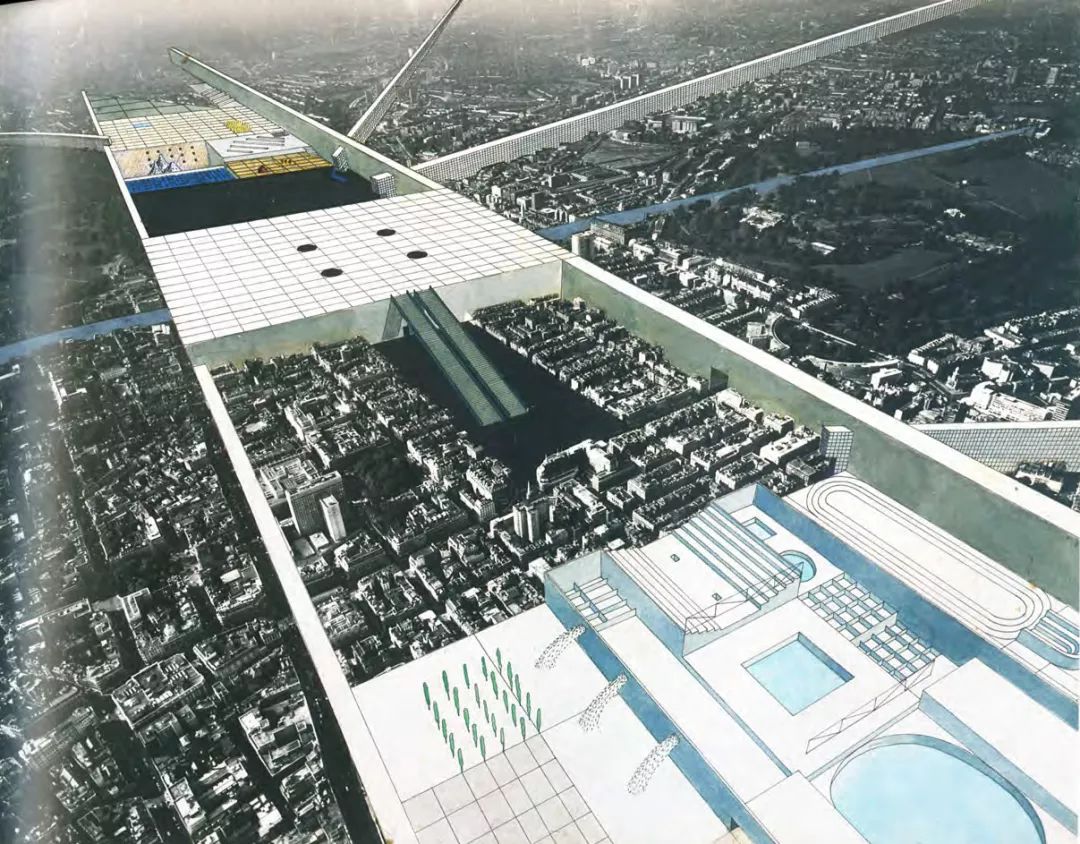
自願的囚徒 The Voluntary Prisoners
這項研究意在描述,在被認為是人類行為低谷的倫敦,如何一步步建立建築綠洲。
猛然間,都市慾望的美好條帶穿過了倫敦的中心。這個條帶就像一條跑道,以供集體紀念碑這樣的新建築落腳。
兩座牆圍合併保護著這片區域的完整性,防止牆外的污穢如腫瘤般逐漸將它吞噬。
不久,第一批囚徒就乞求著進入。
他們數量驟增,如洪流般無法阻擋。
至此,我們見證了一場倫敦大逃離。舊城的結構實體再也無法承受新建築所帶來的衝擊。倫敦將毫無意外地成為一片斷壁殘垣。
This study describes the steps that will have to be taken to establish an architectural oasis in the behavioral sink of London.
Suddenly, a strip of intense metropolitan desirability runs through the center of London.
This Strip is like a runway, a landing strip for the new architecture of collective monuments.
Two walls enclose and protect this zone to retain its integrity and to prevent any contamination of its surface by the cancerous organism that threatens to engulf it.
Soon, the first inmates beg for admission.
Their number rapidly swells into an unstoppable flow.
We witness the Exodus of London. The physical structure of the old town will not be able to stand the continuing competition of this new architectural presence. London as we know it will become a pack of ruins.



條帶 THE STRIP
接下來的圖片是這個條帶的發展的許多時刻的細節。
十一個方形區域有不同程度的設計;它們並不能完全展示這個條帶的方方面面,畢竟讀者們可以一邊讀一遍想像其他必不可少的活動和愉悅。
這個中央條帶只不過是更大的建築飛地綜合體中最猛烈的部分;這裡展示的僅僅包括高社會強度和集體相關的活動。
其他並不是所有人共享的活動位於狹窄的次級條帶中,每一條都與中央條帶有獨特的交接和聯繫。這些次級條帶切過了舊倫敦最令人絕望的貧民窟,由此直接通向這一建築飛地,提供了落腳者們夢寐以求的私人棲身之地。它們之輝煌的存在,使這些貧民窟蛻變成了如畫般的鬼城與廢墟。
中央條帶的鳥瞰和地圖中,自西向東依次是(每個方形之內):
1.條帶尖端。這裡是與舊倫敦矛盾最激烈的地方。這裡,建築的進程肉眼可見。
2.分配地塊。這是個人的地塊,和備受強調的集體設施相平衡。
3.四象公園:氣、火、水、地。
4.紀念廣場,大理石鋪地;這裡用於舉行露天慶典。
5.接待區:在這裡,條帶的神秘生活被介紹給未來的居民。它的屋頂是個觀景平台,俯瞰著整個建築綜合體。
6.通向倫敦舊城保護區的扶梯(納什是這個無情的方案的前兆)。這舊城提醒人們歷史的存在,也同時作為新移民和來訪者的住宅(新環境的閘門)。
7.澡堂。創造、和實現幻想的機構。
8.藝術廣場。
9.囚禁之球
10.生物交易所
11.隱形的攻擊性公園
The following pictures represent a close-up of a particular moment in the development of the strip.
Eleven squares are designed in various degrees of detail; together, they do not show all the aspects of the central strip, other equally essential activities and pleasures can. are being, imagined.
The central strip is only the most intense part of the much larger complex of the Architectural enclave; at the stage shown here it only contains some activities of high social intensity and communal relevance.
Those activities which are not shared by all are located in the narrow secondary strips, which each have their particular attachments to and relationship with the central zone. The secondary strips cut through the most depressed slum areas of the old London. They lead to the enclave and provide all the private accommodation the settlers have dreamt for themselves. Their magnificent presence forces these slums to turn into ghost towns and picturesque ruins.
Within the central strip the map and aerial view show, from West to East, (each contained in their own square):
1. The Tip Condition. The point of maximum friction with the old London. Here the Architectural progress of the zone visibly takes place.
2. The Allotments. Individual plots of land to balance the emphasis on the Collective facilities.
3. The Park of the four Elements: Air, Fire, Water and Earth.
4. The Ceremonial square, paved in marble; it is a place for open-air celebration.
5. The reception area: here future inhabitants are introduced to the mysteries of citizenship of the strip. Its roof is a viewing platform sufficiently elevated to give a view over the complete architectural complex.
6. An escalator descends into the area of London which is preserved (Nash a predecessor of the ruthless plan) as a reminder of the past and as useful housing for migrant visitors and new arrivals (an environmental sluice).
7. The Baths. Institute for the creation and implementation of fantasies.
8. The square of the Arls.
9. The square of the Captive Globe.
10. The institute of Biological Transactions.
11. Invisible is the Park of Aggression.

接待區 Reception Area
跨越圍牆之後,精疲力竭的難民進入了圍牆與接待區之間的大廳。等候廳的守衛對他們悉心關注,周圍瀰漫著來自建築的撫慰氣息。圍牆彼側的教化程序由此開始:新來者進入了接待區。
落腳之時,所有人都受到熱烈的歡迎。接待區的活動需要這些新人接受基礎訓練,這必須通過淹沒先前營養不良的感官來實現。這項訓練是在極樂的條件下進行的:奢侈且幸福。
接待區永遠人滿為患,新人們在這場交易中聯繫亢奮的精神狀態,以隨時作出社會政治的創新。這亢奮在建築中迴響,感官被思想淹沒。
參與者唯一關注的是這個條帶的當下與未來:他們提出建築的改良、加建和策略。慷慨激昂的小組在特殊的房間裡講述方案,而其他人則在不斷地修改模型。最矛盾的提議也會不經任何折衷就相互融合。
After crossing the Wall, exhausted fugitives are received by attentive wardens in a lobby between the Reception Area and the Wall. The consoling atmosphere of this waiting room is an architectural sigh of relief. The first step in the indoctrination program of the other side of the Wall is realized: the newcomers enter the Reception Area.
On arrival a spectacular welcome is given to all. The activities inside the Reception Area require minimal training for new arrivals, which is only accomplished by overwhelming previously undernourished senses. The training is administered under the most hedonistic conditions: luxury and well-being.
The Reception Area is permanentIy crowded by amateurs who through their dealings exercise an inspired state of political inventiveness, which is echoed by the architecture.
The senses are overwhelmed by thought.
The sole concerns of the participants are the present and the future of the Strip: they propose architectural refinements, extensions, strategies. Excited groups elaborate proposals in special rooms, while others continuously modify the model. The most contradictory programs fuse without compromise.

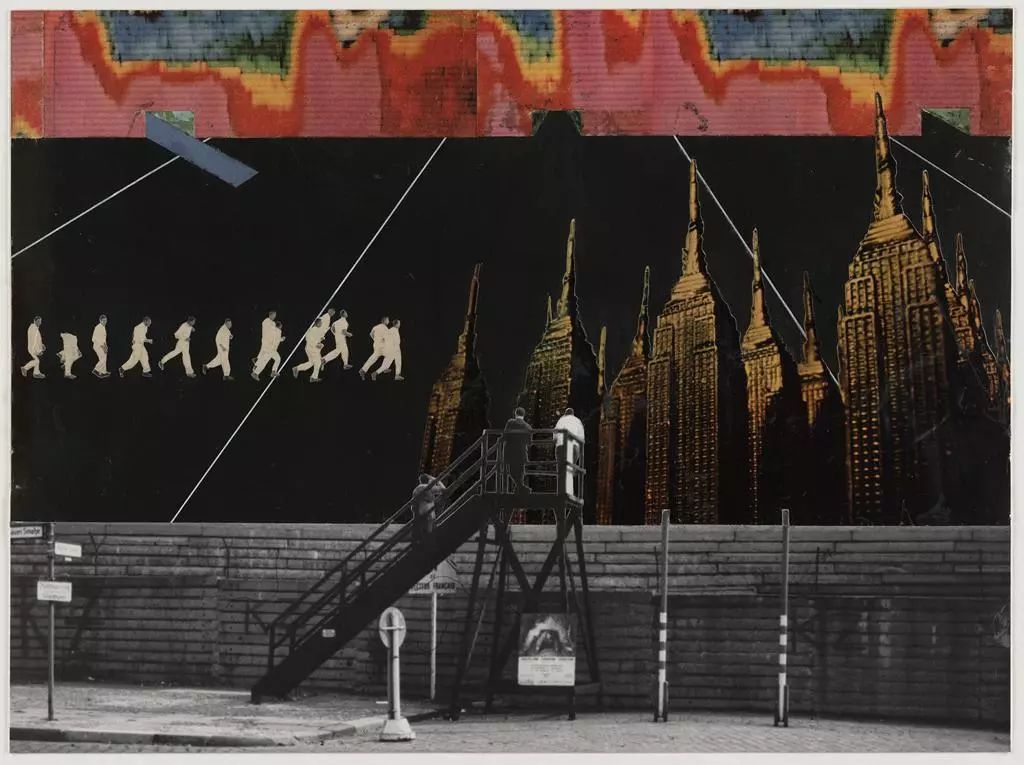
中央區 Central Area
是從建築內部可達的接待區屋頂部分,在這個高台上可以親身感受舊城的衰敗與新城的金碧輝煌。
一個巨大的扶梯從此處通向留存下來的「舊」倫敦片段。
這些古老的房屋為新來的訓練者們提供暫時的棲居之所:這裡(中央區)是環境的閘門。
The roof of the Reception Area, accessible from the inside, is a high-altitude plateau from which both the decay of the old town and the physical splendor of the Strip can be experienced.
From here, a gigantic escalator descends into a preserved fragment of the 「old」 London.
These ancient buildings provide temporary accommodation for recent arrivals during their training period: the area is an environmental sluice.

慶典廣場 Ceremonial Square
屋頂的另一側(西側)空空如也,唯有干擾塔坐落於此,它使條帶中的人們免於暴露在外界的電磁場之下。人們在這個黑色廣場中做著身體與思維的操練,這裡是概念的奧林匹克。
The other (west) side of the roof is completely empty, except for the tower of the Jamming Station, which will protect the inhabitants of the Strip from electronic exposure to the rest of the world. This black square will accommodate a mixture of physical and mental exercises, a conceptual Olympics.
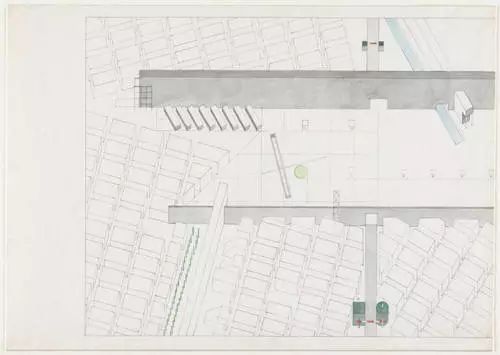
條帶的尖端 Tip of the Strip
這裡是與倫敦舊城的建築戰爭的前沿陣地。這裡,條帶無情的前進步伐是日復一日的奇蹟;這裡,建築的集體狂怒最為猛烈。在與舊城不斷地對抗中,新建築摧毀了舊建築,倫敦的獄友和新條帶的囚徒衝突不斷。一些舊文明的紀念碑目標或功能可疑,但在經歷了思想改造之後被納入了新區域。
這個條帶的建築模型處於不斷的修改之中,接受著從接待區輸入的戰略、計畫和指令。條帶尖端的兵營裡,生活也許是艱苦的,但不斷的創造讓建造者們樂此不疲。
This is the frontline of the architectural warfare waged on the old London. Here, the merciless progress of the Strip performs a daily miracle; the corrective rage of the architecture is at its most intense. In a continuous confrontation with the old city, existing structures are destroyed by the new architecture, and trivial fights break out between the inmates of the old London and the Voluntary Prisoners of the Strip. Some monuments of the old civilization are incorporated into the zone after a rehabilitation of their questionable purposes and programs.
A model of the Strip, continuously modified through incoming information from the Reception Area, conveys strategies, plans, and instructions. Life in the building barracks at the Tip of the Strip can be hard, but the ongoing creation of this object leaves its builders exhausted with satisfaction.

四象公園
The Park of the Four Elements
四象公園分成四個方形廣場,通過四個巨大的台階消失在大地中。
一者名為「氣」。其中數座下沉大廳裡是錯綜複雜的管道,散發著混雜的氣體,給人芬芳與幻覺。通過劑量、濃度、甚至是顏色的微妙調整,人們可以操縱揮發性的呼吸雲霧,就像玩弄樂器。狂喜、抑鬱、寧靜、開放,這些情緒在這裡無形地發生,或是按順序與節奏編排,或是即興變幻。豎向的空氣簾幕保證了大廳之外的空氣不受污染。
二者名為「漠」。它的大小與前者相同,但大廳沉於地下。其中是人工重建的埃及風景,模擬了讓人頭暈目眩的情景:金字塔、綠洲、以及一件火器——鋼架上噴出無數的火焰,強度、色澤與熱量各不相同。
這件火器在夜晚表演,在條帶的任何角落都可觀看。它是煙火奇觀,是夜中明日。旅途最後的線性的洞窟裡,機器投影出慾望的理想海市蜃樓。
從沙漠中進入這些管道的人,徑直衝向這些天人合一的圖像,但沒人能感受到真正的聯結:他們正在一條機械跑道上,離這些幻象越近,這條跑道向後運動地也就越快。這些沮喪的能量和慾望最終會被引導至昇華的行為裡。(於是,金字塔中並沒有寶庫將成為永遠的秘密。)
地層更深處,名為「水」,水池的表面永不平靜。隨著一堵作著規律而有變化的運動的牆,不斷產生波動,有時甚至掀起驚天巨浪。這湖是尋歡者的國度,他們早已痴迷於征服這些波濤。日以繼夜,這室內海洋成為了條帶上各類活動的背景音。
四者名為「地」,在這個坑的最下方。其中的山似曾相識,山峰的高度與條帶的表面精準持平。山頂上,一群雕塑家為了在石頭上刻誰的頭像而爭論不休;但在這監獄愈演愈烈的氛圍下,沒人能擁有持續的強大影響力,讓這一爭論有個結果。
這個深坑的四壁上似是傷痕纍纍,講述著這裡的過去;一條曾經廢棄的舊地鐵線懸於空中。在其他牆壁的深處,充滿了洞穴居所或集會所,人們在裡面舉行原始的神秘儀式。
逐層遊覽這四個方形廣場之後,漫遊者乘坐扶梯重新回到表面。
Divided into four square areas, the Park of the Four Elements disappears into the ground in four gigantic steps.
The first square, 「Air,」 consists of several sunken pavilions overgrown with elaborate networks of ducts that emit various mixtures of gasses to create aromatic and hallucinogenic experiences. Through subtle variations in dosage, density, and perhaps even color, these volatile scented clouds can be modified or sustained like musical instruments.
Moods of exhilaration, depression, serenity, and receptivity can be evoked invisibly in programmed or improvised sequences and rhythms. Vertical air jets provide environmental protection above the pavilions.
Identical in size to the first square but sunken below surface level is 「Desert,」 an artificial reconstruction of an Egyptian landscape, simulating its dizzying conditions: a pyramid, a small oasis, and the fire organ a steel frame with innumerable outlets for flames of different intensity, color, and heat.
It is played at night to provide a pyrotechnic spectacle visible from all parts of the Strip, a nocturnal sun.
At the end of tour linear caves, mirage machines project images of desirable ideals.
Those in the Desert who enter the tubes run to reach these beatific images. But actual contact can never be established: they run on a belt that moves in the opposite direction at a speed that increases as the distance between mirage and runner shrinks. The frustrated energies and desires will have to be channeled into sublimated activities. (The secret that the pyramid does not contain a treasure chamber will be kept forever.)
Deeper still into the earth is 「Water,」 a pool whose surface is permanent I y agitated through the regular but variable movement of one of its walls, producing waves of sometimes gigantic proportions. This lake is the domain of some pleasure seekers, who have become completely addicted to the challenge of the waves. Day and night, the sounds of this interior sea serve as the acoustic background to the activities of the Strip.
The fourth square, at the bottom of the pit, 「Earth,」 is occupied by a vaguely familiar mountain, its summit precisely level with the surface of the Strip. At the top, a group of sculptors debate whose bust to carve into the rock; but in the accelerated atmosphere of this prison, no one is important long enough for them ever to reach a conclusion.
The walls of the cavity repeat the past history of this location like a scar; part of a now deserted Underground line is suspended in this void. Deep in the other walls, cave dwellings and cavernous meeting places are carved out to accommodate certain primordial mysteries.
After spiraling through the tour squares, the wanderer is returned by an escalator to the surface.


澡堂
Baths
私人與集體的幻想在澡堂裡創造、循環;新奇的行為在這裡發明、測試、引進。這幢房子是一個社會凝聚器。
它致使隱藏的動機、慾望和衝動浮現於表面,經提煉後被認知、挑釁和發展。
地面層用於公共活動和展示,性格和肉體在此不斷遊行,於是這裡成為了展示與觀看的辨證循環的舞台。這是觀察者的領域,潛在的伴侶勾引著對方,並試圖相邀投入更私密的幻想與慾望。
建築兩側的長牆由數不盡的大小不同的房間(cell)組成,以供個人、夫妻或小群體退休之後居住於此。這些房間的室內設備供人放縱享受、實現幻想或社交創造;房間內歡迎一切形式的互動交流。
公共空間/私密房間的序列產生了創造性的連鎖反應。房間裡成功的表演者、或自信自己的行為與提議原真有效的人,被分配進澡堂兩端的兩個競技場。最終,他們在競技場裡,表演。這些表演的新鮮和隱喻激活了大腦中沉睡的神經,觸發了觀眾的思維爆炸。自願的囚徒們因這一奇蹟場面大腦過載,他們選擇走向地面,尋找願意一起實踐新方案的同伴。
The function of the Baths is to create and recycle private and public fantasies, to invent, test, and possibly introduce new forms of behavior. The building is a social condenser.
It brings hidden motivations, desires, and impulses to the surface to be refined for recognition, provocation, and development.
The ground floor is an area of public action and display, a continuous parade of personalities and bodies, a stage for a cyclical dialectic between exhibitionism and spectatorship. It is an area for the observation and possible seduction of partners who will be invited to participate actively in private fantasies and the pursuit of desires.
The two long walls of the building consist of an infinite number of cells of various sizes to which individuals, couples, or groups can retire. These cells are equipped to encourage indulgence and to facilitate the realization of fantasies and social inventions; they invite all forms of interaction and exchange.
The public area/private cells sequence becomes a creative chain reaction. From the cells, successful performers or those confident about the validity and originality of their actions and proposals filter into the two arenas at both ends of the Baths. Finally, in the arena, they perform. The freshness and suggestiveness of these performances activate dormant parts of the brain and trigger a continuous explosion of ideas in the audience. Overcharged by this spectacle, the Voluntary Prisoners descend to the ground floor looking for those willing and able to work out new elaborations.

藝術廣場。
Square of the Arts
藝術廣場是這個條帶的工業區和開放空間,各種物件被創造、進化和展示,人們獻身於此以加速前進的步伐。藝術廣場內的材質是和諧的交響曲,為使用者提供了舒適的工作環境。在這個表面上散佈著一系列建築,人們去那裡滿足自己對物件的熱愛。
廣場上有三個主要建築。其中一個很舊;它自始至終都是一個博物館。另外兩座則由那些自願的囚徒建造。其一在表面上突起;是一個構築物。第二座建築從廣場表面向下挖,其挖出的材料被用來建造第一座建築,於是成了第一座建築的室內部分。誰也不能第一眼看出這兩座雙胞胎建築其實是一體的,哪怕這並不是秘密。它們一起構成了現存文化傳宗接代的工具,過去被通過唯一可行的方式呈現了出來:記憶的空白被旁觀者們迸發的感情所充溢,由此記憶被暴露出來。它們是一個學校。第一座建築強而敦實,無法穿透,使柵欄外等待著的學生倍加期待,而第二座建築的空洞則激起了焦慮與懸疑。來訪者們被一股不可抗拒的力量驅使,由扶梯向下開始自己的旅途。他們穿越一系列充滿謎團的展廳,隨後探索歷史最神秘的角角落落。在最下層的展廳裡,他們發現有一個無底的室內:新的展館仍在施工。一條隧道似是通向舊博物館,陌生的作品從中湧出,每當一個展館建成就將其填滿。
回到表面之後,這旅途的痕跡被投影在視網膜上,然後傳輸到大腦特定的區域。
老建築往往蘊含著被抹掉的過往畫面。
無知的遊客對這裡的第一印象總是無盡的空畫框、白畫布、和空基座,唯有對過往有所瞭解的人才能解讀這些奇觀。他們將自己的記憶投射在這些空蕩蕩的挑釁物上:放映出源源不斷的影像,包含過去的畫面與變化,以及藝術發展史上不斷產出的新作品。於是這個空間充滿了回憶、修正與創造。
除了這三棟主要建築之外,這個廣場上可感知的展品僅剩一些小建築們,它們就像上古棋盤上的小卒,如隕石一般隨機散落,意義玄幻,等待著被弈者掿往下一個位置;每一步都是進一步破譯。
Devoted to the accelerated creation, evolution, and exhibition of objects, the Square of the Arts is the Strip’s industrial zone and urban open space paved in a synthetic material that offers a high degree of comfort to its users. Dispersed on this surface are the buildings where people go to satisfy their love for objects.
There are three major buildings on the Square. One IS old; It has always been a museum. The other two were built by the Voluntary Prisoners. The first bulges from the surface; it was built with the materials of the second, which was carved out of the Square and is in fact the interior of the first. At first sight it is impossible to understand that these twin buildings are one, and that this is not a secret. Cooperatively forming an instrument for the indoctrination of the existing culture, they display the past in the only possible way: they expose memory by allowing its provocative vacuums to be filled with the explosive emotions of onlookers. They are a school. The density and impenetrability of the first building intensifies the expectation of arriving students who wait outside its gates, while the apparent emptiness of the second provokes anxious suspense. The visitors, driven by an irresistible power, begin a journey down the escalators that link a series of enigmatic galleries into an exploration of the most mysterious corners of history. At the lowest gallery, they discover a bottomless interior; new galleries are under construction, filling, as completed, with unfamiliar works that emerge in a continuous flow from a tunnel that is seemingly connected to the old museum.
Returning to the surface, the traces of this course are retained on the retina and transferred to certain parts of the brain.
The old building contains erased pictures of the past. The uninformed visitor’s first impression is of an almost infinite number of empty frames, blank canvases, and vacant pedestals. Only those with knowledge acquired on the previous course can decipher the spectacle by projecting their memories onto these empty provocations: a continuous film of images, improvements, and accelerated versions of the history of art automatically produce new works, filling the space with recollections, modifications, and inventions.
Apart from these three main buildings, the only tangible exhibits in the Square are small buildings that resemble pawns on the grid of an ancient game. They are dropped like meteorites of unknown metaphysical meaning, waiting to be moved to the next intersection of the game; with each move they are further deciphered.

囚禁之球
THE SQUARE OF THE CAPTIVE GLOBE
這個方形致力於各種理論、解讀、思想建構和提議,對其人工塑性並催速誕生,而後將這些新想法強加於世界上。
這是自我之都,科學、藝術、詩歌與其他特定形式的狂熱在此競相爭豔,其競爭環境理想而相同。人們發明形而上學的答案,提出社會組織的變革,摧毀並重建世界的現象真實。
這將是意識形態的溫室。這意識形態無法吞噬世界,不會承認任何侷限的現象而壓制他者。每一個這樣的科學或狂熱都有自己的地塊,其上是一模一樣的拋光石材的基礎。這些基石是意識形態的實驗室,用以暫時懸置不受歡迎的法律和無可爭議的事實、創造未曾存在的物質與精神狀況、推動並激勵前瞻的活動。
從這些敦實的花崗岩體塊開始,每一束哲學思想直衝雲霄;這些體塊不斷生長(體量和之內的思想活動的受歡迎度、熱情與道德容量成正比),將容納更多的住宅、數據存儲、捏造的證據、等等……
同時,這些塔會成為思想的物質化身和符號,成為潛意識交流的奇蹟。
有些基礎石塊想展現確切而寧靜的臂膀,而另一些則選擇了更鬆軟的環境,表達其試探性地揣測和致幻又令人質疑的暗示。
這些極端的肢干形成意識形態的展覽,在遠處恍然若現,在近處能仔細端倪;學生們自發的來觀看基石與塔樓的展覽,他們仔細地觀察、批判和對比之後,將不可抗拒地選擇加入並參與其中,詳細分享自己的科學、詩歌與瘋狂。
這個方形是條帶的大學。
這意識形態的天際線,是永恆變換的豐富奇觀,它是精神狂熱、道德愉悅、智力意淫。
如果有一座樓倒塌,那將代表如下二者之一:失敗、放棄和設想的撤退,抑或是視覺尤里卡的驚嘆。
證實的理論
不去的狂熱
存在的思想
成真的謊言
長眠的美夢
在這些時刻,懸於這個方形中央的囚禁之球將會顯形:所有的機構一起組成了世界自身的巨型溫室。這些機構在這地球上產卵、將其改變,又不斷疊加新的內容。
這些建築和他們的激情的調查者們吞噬了事實、物件和現象,只為湧泉相報。
囚禁之球不斷增重——緩慢增溫——它悄然無息地生長。
就算它命途多舛、飽經羞辱,其母體青春長存。
我們帶著聽診器,密切關注著意識形態。問題是(我們對答案並不悲觀):誰先破裂?
是這不可能之卵的殼,還是我們自己?
This square is devoted to the artificial conception and accelerated birth of theories, interpretations. mental constructions and proposals, and their infliction on the World.
It is the capital of Ego, where science, art, poetry and certain forms of manias will be allowed to compete under ideal and identical conditions, to invent the answers to metaphysical questions, to propose changes in social organization, to destroy and restore the World of phenomenal reality.
It will be an incubator of ideologies, which will not be permitted to consume the world, to recognize only certain phenomena and suppress others. Each of these sciences and manias has its own plot. On each plot stands an identical base, built from heavy polished stone. These bases, ideological laboratories, are equipped to temporarily suspend unwelcome laws, undeniable truths, to create nonexistent physical and mental conditions, to facilitate and provoke speculative activities.
From these solid blocks of granite, each philosophy expands indefinitely towards heaven; This growth from the blocks (in direct proportion to the popular appeal, excitement and moral volume of the intellectual activities inside) will house additional accommodation, data storage, fabricated evidence, etc. …
At the same time, these towers will be the visualizations, and symbols of these ideas, a spectacle of sublime communication.
Some of the basic blocks will want to present limbs of complete certainty and serenity, others will choose a soft environment of tentative conjectures and hypnotic, but questionable suggestions.
These extremities, these limbs will form an ideological exhibition, visible from afar, and scrutinized from nearby; the visitors to this exhibition will be spontaneous students, a close inspection and critical comparison of the blocks and towers will create the irresistible urge to choose, join and participate, to share and elaborate a science, a poem, a madness.
This square is the university of the Strip.
The changes of this ideological skyline will be rapid and continuous, a rich spectacle of moral fever, ethical joy. or intellectual masturbation.
The collapse of one of these towering structures can mean two things: failure, giving up, a vacating of the premises, or, the exclamation of a visual Eureka.
A Theory that works
A mania that sticks
An idea that is
A lie that has become truth
A dream from which there is no waking up
On these moments the purpose of the Captive Globe, suspended in mid-air in the center of the square, becomes apparent: all these institutes together form an enormous incubator for the World itself. They are breed ng on the globe, changing it, adding something to its contents.
These buildings and their passionate investigators have consumed facts, objects, and phenomena, in order to give more and better in return.
The globe gains weight. – Its temperature rises slowly. – Invisibly it grows.
In spite of the most humiliating setbacks, its ageless pregnancy survives.
We all have our ear on the stethoscope of the ideologies. The question is (and we are not too pessimistic about the answer): who will crack first?
The skin of this impossible egg, or perhaps ourselves?

生物交易所
Institute of Biological Transactions
生物交易所以生物危機和身心健康為由,綁架了這些自願的囚徒;它也證明死亡全然無害。
生物交易所的建築如十字架般分成四翼。第一部分是醫院,它是現代醫療的軍械庫,卻致力於醫療過程的降級,並削弱痊癒的慾望。這裡沒有人造的心跳,沒有化學污染,沒有虐待狂式的續命。這項新策略減少了平均期望壽命,也因此減少了衰老、體弱、噁心和疲憊。實際上這裡的病人都很「健康」。
醫院中的樓呈空間序列,每一棟樓針對一項病症,由醫療大道連接在一起——一條緩緩移動的傳送帶上展示了患病過程,一組護士穿著透明的制服手舞足蹈,醫療設備偽裝成圖騰,濃烈的香水掩蓋住熟悉的病患氣息,氣氛如慶典和歌劇一般。
醫生從傳送帶上選擇自己的患者,邀請他們到自己的單間,測試生命體徵,談笑風生地炫耀自己的(醫學)知識。如果他們失敗了,患者就被送回傳送帶,也許另一個醫生會再試一下這個患者,但顯然這個傳送帶之後會穿越所有醫院的樓、穿過整個十字架,直接進入墓地。
The Institute sustains the Voluntary Prisoners through biological emergencies and physical and mental crises; it also demonstrates the harmless nature of mortality.
It is divided into four parts by a cruciform building. The first part, the hospital, contains the complete arsenal of modern healing, but is devoted to a radical deescalation of the medical process, to the abolition of the compulsive rage to heal. No forced heartbeats here, no chemical invasions, no sadistic extensions of life. This new strategy lowers the average life expectancy and with it, senility, physical decay, nausea, and exhaustion. In fact, patients here will be 「healthy.
The hospital is a sequence of pavilions, each devoted to a particular disease. They are connected by a medical boulevard -a slow-moving belt that displays the sick in a continuous procession, with a group of dancing nurses in transparent uniforms, medical equipment disguised as totem poles, and rich perfumes that suppress the familiar stench of healing, in an almost festive atmosphere of operatic melodies.
Doctors select their patients from this belt, invite them to their individual pavilions, test their vitality, and almost playfully administer their (medical) knowledge. If they fail, the patient is returned to the conveyer; perhaps another doctor tries the patient, but it soon becomes apparent that the belt leads beyond the pavilions, through the cruciform building, and straight into the cemetery.
這裡是永恆的慶典。亙古不變的氣味和舞蹈,與暗黑色灌木叢和地塊上無情的建築形式相比,要有人情味得多。
在這個方形的另一部分,是降生三殿。生死於斯,數據守衡。這兩者之間的關係之不莊重、交接之溫潤,撫慰人心。縮短的壽命使人產生急切的野心;它絕不容忍不盡開發的大腦、人為延長的童年以及浪費的青春。降生三殿也會照顧嬰兒,教育兒童,並將他們培養成為能積極參與條帶生活的小大人——越快越好。
The mood here is continuously festive. The same smells, the same ethereal dance, are made still more human by the contrast between the ruthlessly form allay out of the plots and the unnaturalness of the dark green shrubbery.
In another part of the square, the Three Palaces of Birth, there is a statistical balance between births and deaths. The physical proximity of these events suggests the consolation of a causal relationship between the two, a gentle relay. The lowering of the average life expectancy creates an ambitious urgency; it does not allow the luxuries of underexploited brains, the artificial prolongation of childishness or wasted adolescence. The Three Palaces of Birth will also care for babies, educating them and turning them into small adults who -at the earliest possible date – can activefy participate in life in the Strip.
第四部分中,精神病患者一如往常地被展出。不是作為病患自身,而是作為精雕細琢的幻象的一部分,這些幻象被尖端設備所維持:無數的拿破崙、南丁格爾、愛因斯坦、耶穌和聖女貞德穿著自定的服飾。
最後,是十字架建築本身,它分開了上述四個部分,裡面藏有從古至今所有囚徒的生命數據和成長過程。官僚主義雖常常因狂熱控制、輕視隱私和道德淪喪被批判,但它卻賦予了這些囚徒一種新型的永生:強大無比的計算機裡連著數據的寶庫,眨眼間就能寫出逝者的人生傳記,以及未截稿的生者傳記——既定的事實與無情的推演——被用作規劃人生前途的重要工具。
In the fourth part, mental patients will be on display as in former days, not as themselves but as part of a well-produced exhibition of their delusions, sustained by the most advanced technical equipment: an infinite number of Napoleons, Florence Nightingales, Einsteins, Jesus Christs, and Joans of Arc all in their custom-made uniforms.
Finally, the cruciform building, which separates the four compartments, contains the archives- records of all vital facts, developments, and life incidents of past and present Prisoners. Bureaucracy, so often criticized for its passion for control, contempt for privacy, and moral blindness, guarantees the Prisoners a new kind of immortality: this statistical treasure, linked to the most imaginative computers, produces not only instant biographies of the dead in seconds, but also premature biographies of the living -mixtures of facts and ruthless extrapolations -used here as essential instruments for plotting a course and planning the future.

攻擊性公園
Park of Aggression
在這個娛樂區裡,矗立的原始結構將人們的攻擊慾望誘導成為創造性的對抗。展開的本我/世界使千姿百態的意識形態在此綻放。而它們的強制並存,喚起了人們幼時的夢想和玩耍的慾望。這個公園裡永遠存儲著蓄勢待發的矛盾和張力,它是個尺度可變的巨型遊樂場,而其中的活動只有一個:攻擊。
在這裡,衝突被重新合法化:文明行為裡那種腐蝕性的情感過剩,被舞台上的戰鬥所消融。對個體而言,這公園又是患者的避難所,他們為了從舊世界感染的殘餘中康復:偽善與自殺。診斷提供了諸多新的交媾方式。最突出的建築物是兩座塔。一座是無休無止上升的螺旋;另一座是建築風格熟悉的42個平台。兩塔之間的磁場產生了一種能映射使用者心理動機的張力。
公園是免費的,表演絡繹不絕;來訪者或獨行、或成雙、或成組。玩家們自信滿滿,消解了方形高塔帶來的巨大不確定性和不安全感。塔中是一列列的房室,來訪者退居其中,將壓抑已久的憎恨毫無顧忌地發洩在對方身上。
In this recreational area, rudimentary structures were erected to correct and channel aggressive desires into creative confrontations. The unfolding ego/world generates the continuous emergence of conflicting ideologies. Their imposed coexistence invokes childish dreams and the desire to play. The Park is a reservoir of sustained tension waiting to be released, a gigantic playground of flexible dimensions to accommodate the Strip’s only sport: aggression.
Here, conflicts are reenacted: the staged battles dissolve the corrosive hysteria of good manners. On an individual level, the Park is a sanatorium where patients recover from remnants of Old World infections: hypocrisy and genocide. The diagnoses provide richer forms of intercourse. The most prominent edifices are the two towers. One is infinite, a continuous spiral; the other, consisting of 42 platforms, has a familiar architectural style. Magnetic fields between these towers create a tension that mirrors the psychological motivations of their users.
Entry to the Park is free, and performances are continuous; visitors arrive alone, in pairs, or in small groups. The aggressive confidence of the players compensates for the electrifying uncertainty about the safety of the square tower. Inside the tower are shelves containing cells where visitors withdraw to vent suppressed hatred, freely abusing each other.
但這些對抗者個體同時也是觀眾:這一列列房室也是面朝塔中大平台的觀看廳,(這樣的空間排布)激起了其他來訪者在下面的平台上成組,進行不明所以的身體交易。僅存的羞恥心也被克服,來訪者們將各自的能量不遺餘力地灌注在這扭曲的社會行為中。在一場煩亂的睡眠裡,他們在塔中攀登;他們每上一層樓,看見下面的視角也就越好,於是在這高聳的建築周圍,他們體驗了豁然開朗、精神抖擻的感官奇蹟。
塔向前傾斜,將這些對抗者無情地推向自省的螺旋和深淵。它的消化蠕動吞噬著多餘的心慈手軟:這是皮下脂肪的燃燒室。這些人體導彈被離心加速,選擇螺旋尖塔外牆的開口逃逸。它們是匯聚了恐怖能量的物件,被拋入了不可抗拒的誘惑的軌道。
整個公園的表面——其上的空氣和其下的洞窟——組成了宏大的戰場。隨著活動持續進入深夜,它逐漸變成了致幻的慶典模樣,而牆外廢棄世界的精準滅絕與旖旎靜滯則成為了幕布。夜間的探險結束後,來訪者前往一個斜跨整個條帶的巨大競技場裡慶祝集體的凱旋。
But these private antagonists are also spectators: the shelves serve as viewing galleries which overlook the larger platforms of the tower, provoking visitors to join groups involved in unknown physical transactions below. As remnants of shyness are overcome, visitors add their private energies to this incredibly demanding and mutant form of social behavior. In an agitated sleep, they ascend the tower; as they pierce each floor, their view of the activity below improves, and around the architecture of great height they experience an exhilarating new sensation of the unfolding spectacle.
As their tower leans forward, they push their antagonist into an abysmal fall through the relentless spiral of introspection. Its digestive movements consume excessive softness: it is the combustion chamber for the fat underneath the skin. The human missiles, helped by centrifugal acceleration, escape through a chosen opening in the walls of the spiral. They are objects of terrifying energy released into a trajectory of irresistible temptations.
The entire surface of the Park -the air above and the cavities below -becomes a full scale battlefield. As the operations continue into the night they take on the appearance of hallucinatory celebrations against the backdrop of an abandoned world of calculated extermination and polite immobility.
As they return from their nocturnal adventure, the visitors celebrate their collective victories in a gigantic arena that crosses the Park diagonally.

分配地塊
The Allotments
為了從猛烈的集體主義需求中挽回些許私密,每個自願的囚徒都有一小塊土地,以供自己修身養性。這些地塊上的房屋由最昂貴奢侈的材料建成(大理石、鉻、鋼);它們是人們的小型宮殿。在無恥的潛意識裡,這些看似簡單的建築暗中實現了自己的野心,致使人們心懷滿足與感激。
這些分配的地塊受到嚴密監視,以至於任何內外騷動都可以避免,或至少被迅速鎮壓。
這裡的媒體輸入為零。禁止使用紙張,收音機神秘地失靈,整個「新聞」的概念被扭曲,取而代之的是對辛勤耕耘這些地塊的耐心奉獻;房屋的表面被擦洗、拋光、潤色。時間抑止。
這裡無事發生,而空氣中瀰漫著沉重的興奮的氣息。
To recover in privacy from the demands of intense collectivism, each Voluntary Prisoner has a small piece of land for private cultivation. The houses on these Allotments are built from the most lush and expensive materials (marble, chromium, steel); they are small palaces for the people. On a shamelessly subliminal level this simple architecture succeeds in its secret ambition to instill gratitude and contentment.
The Allotments are well supervised so that both external and internal disturbances can be avoided, or at least quickly suppressed.
Media intake in this area is nil. Papers are banned, radios mysteriously out-of-order, the whole concept of 「news」 ridiculed by the patient devotion with which the plots are plowed; the surfaces are scrubbed, polished, and embellished. Time has been suppressed.
Nothing ever happens here, yet the air is heavy with exhilaration.

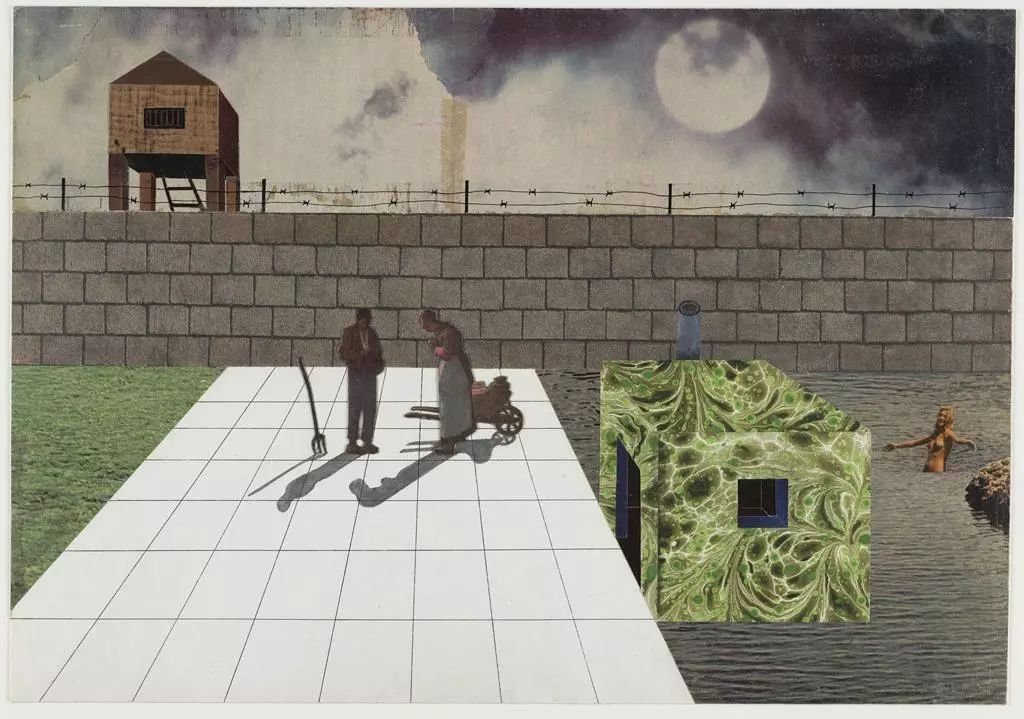
The Avowal
誓言(原文法語,由Stefan weber翻譯成英文)
From this terrible landscape,
Which no mortal eye ever saw,
The vague and distant picture,
would still enlighten me this morning…
九泉之下,
此景滿目蒼夷,
恍然若現,
朝而醍醐灌頂。
I had banned from this spectacle
all the irregular greens…
神工之殿,
綠色格格不入
我將其斷然禁絕…
On my projected image I enjoyed
The intoxicating monotony
Of metal, marble and water.
如痴如醉,
於我腦中投影,
味同嚼蠟,
是其金石流水。
A Babel of stairs and arcades,
It was an eternal palace,
Full of pools and waterfalls
Pouring into opaque or darkened gold;
廊腰縵回,
矗此不竭之宮,
長橋臥波,
去於黯金之淵。
And water plunged down heavily,
Like crystal curtains,
Which are dazzlingly suspended
On the metal forts.
飛流直下,
懸於銅牆鐵壁,
玲瓏秋月,
來者目不暇接。
Not trees but colonnades,
Surrounding the sleeping ponds,
Where gigantic river nymphs,
Of female aspect, mirrored themselves.
綠樹景行,
清池酣然入夢,
髣髴青雲,
鏡影飄搖若仙。
Blankets of blue water pour out,
In-between carpets of roses and plants,
Counterparts of millions of places,
At the border of the universe;
綠草如練,
碧水春紅細柳,
寰宇之限;
皆是鏡花水月。
Those unheard-of minerals
And magical streams; That
Immense and dazzling ice
All over where they reflected themselves.
珍金異石,
凝於百丈之冰
奇風神水,
煌然對影成雙。
And everything, even the black colour,
seemed polished, bright, shining, …
世間萬物,
甚於玄冥之色,
皆似在熠熠生輝…
No luminaries elsewhere,
neither remnants of the sun,
not even in the lowest skys,
to lighten these prodigious children
which shine by their personal fire !
黑雲夜紫,
人間不見天日,
神童心火,
卻如萬丈光芒!

跋
Epilogue
雖說第一眼看上去這些信息和提議的隱喻蓋過了其實際意義,但這絕不是另一個烏托邦。
這個區域今天就可以被建造(必要的話,可以是片段,也可以在別的基地。這些片段大抵是像石頭一般散佈的,彼此相隔一定距離,其擲入都市之池的漣漪相互疊加碰撞,也僅因此相連。它們就如真正的社會凝聚器一般)。這需要人們堅信,城市是社會慾望的溫室,是所有慾望的物質化集成。如果人們能熟知建築,他們將決定重修精神與物質的城市社會生活,將其改造成為都市理想的生活圖景。
在末世的危機下,集體無意識的、癲狂而寬容的共同努力中,個體慾望的實現似被吞沒,這成為了普遍的擔憂。
這導致了幻想的提議,畢竟現實的匱乏之下,唯有幻覺能繼而給人慰藉。
就像美杜莎的木筏上的流放者一般,最後存活的現實主義者緊攥著希望之羽翼,降落在救援船上:城市,終於在野蠻時代之後,浮現於天際。
Although at first sight the metaphorical message of these proposals may seem to dominate practical considerations, this is not another Utopian tale.
The zone can be built today (if necessary, in segments, perhaps with a modified location, perhaps with the segments dropped like stones, apart from each other, and only connected by the overlapping ripples caused by their impact on the urban pond, i.e. like true social condensers). It requires a fundamental belief in cities as the incubators of social desires, the synthetic materializations of all dreams. If people were allowed to become acquainted with Architecture, they would decide to re-appropriate the physical and ideological decay of our Urban Societies and to rehabilitate their premises with the metropolitan ideal and life style. Under the threat of doom, the common concern, that is the fulfilment of all private desires within a subliminally collective and deliriously permissive common effort, produces phantom proposals, in the knowledge that phantom reality is the only possible successor to the present reality shortage.
Like the castaways on the raft of the Medusa, the last surviving realists, hanging on the parachute of hope are dropping on the rescue ship: THE CITY which, at the end of cannibalism, will appear on the horizon.

後記
文章的筆吻是宣言式的。建築成為了城市社會慾望的容器,而這些慾望發生的場景充滿了血腥、暴力、色情,顯然意圖讓讀者不適。然而結尾的小詩卻無比美麗,人們沉浸在美好的慾望生活中無法自拔,且文末庫哈斯竟也毫不質疑這樣的烏(異)托邦將會被建造,這與主旨清晰的《美麗新世界》截然不同。畢竟「作者已死」,也許他的本意就是創造一系列不加闡釋的「概念片段」,以供讀者去解讀。
另一方面,Bernard Tschumi 說:「這篇文本並不想描述建築,它即是建築本身」。這一作品沒有圖像也許仍能理解,但沒有文本則是讓人一頭霧水。以人們對場景和圖紙的感知是整體的、同時的、感官的,而對文本的認知則更為線性、有時間順序、思維。可以說,本作品為代表的1970年左右的許多文本,可以說將文本既視為設計和分析的手段,也作為表達方式,帶入了建築學的話語體系。
